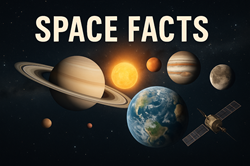Step into the wonders of the cosmos—where every fact reveals a new mystery. At FanaticalFacts.com, our space facts ignite curiosity, fuel imagination, and remind us how vast, beautiful, and full of possibility our universe truly is.
Space Facts – Visual Art Style
Type – A photorealistic digital illustration in a cinematic science style

At FanaticalFacts.com, every Space Fact is brought to life through a photorealistic digital illustration in a cinematic science style. This visual approach blends scientific accuracy with dramatic composition—featuring realistic textures, glowing starlight, shadowed planets, and a sense of cosmic scale.
Driving to The Moon

Drive straight to the Moon
If you could hop in a car and drive straight to the Moon at 100 mph (160 kph), the journey would take about 99 days—nonstop! At a more typical speed of 60 mph (97 kph), you’d need around 166 days to complete the cosmic road trip. Of course, there are no lunar highways, but it’s a fun way to grasp the distance: roughly 238,855 miles (384,400 km) from Earth. And here’s a twist—our Moon is slowly drifting away from us at about 1.5 inches (3.8 cm) per year!
More Stars than Sand Grains
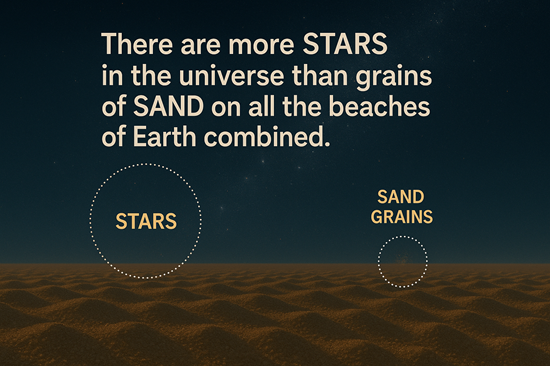
More stars in the universe than grains of sand
There are more stars in the universe than grains of sand on all the beaches of Earth combined. Scientists estimate the observable universe contains around one septillion stars—a truly mind-blowing number. This incredible space fact highlights the vastness and mystery of the cosmos, reminding us how much there is to explore beyond our planet.
Teaspoon of Neutron
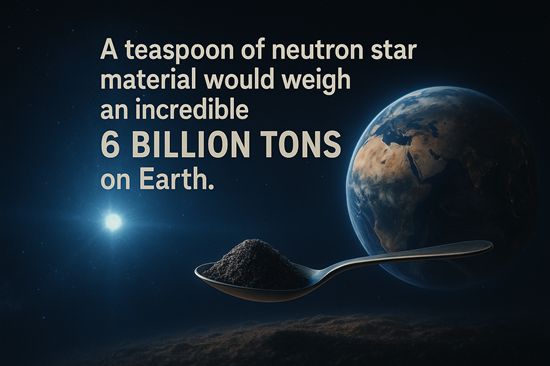
A teaspoon of neutron star
A teaspoon of neutron star material would weigh an incredible 6 billion tons on Earth. Neutron stars are the dense remnants of massive stars that exploded as supernovae, packed into a sphere only about 12 miles wide. This amazing space fact highlights the extreme and mind-boggling conditions that exist in the universe, showing just how strange and powerful cosmic objects can be.
Jupiter’s Red Spot
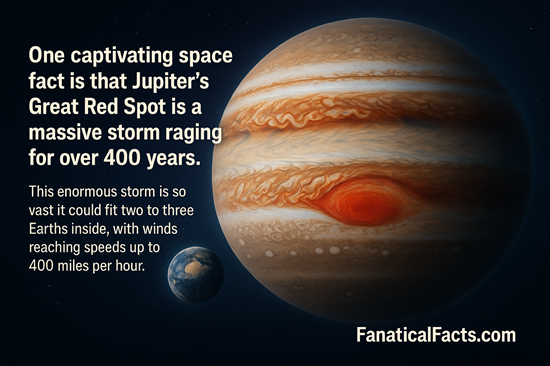
Jupiter’s Great Red Spot
One captivating space fact is that Jupiter’s Great Red Spot is a massive storm raging for over 400 years. This enormous storm is so vast it could fit two to three Earths inside, with winds reaching speeds up to 400 miles per hour. This incredible space fact showcases the powerful and dynamic weather systems beyond Earth, highlighting the fascinating complexity of our solar system. FanaticalFacts.com!
Coldest Place – Nebula
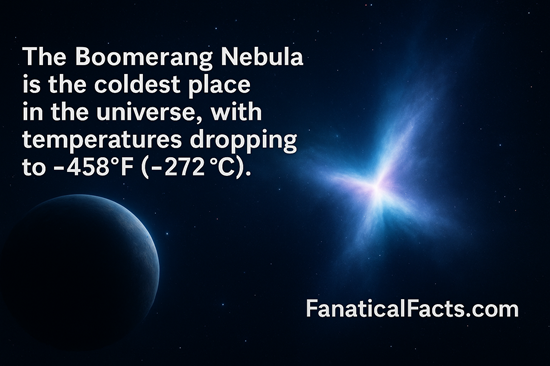
The Boomerang Nebula
The Boomerang Nebula is the coldest place in the universe, with temperatures dropping to -458°F (-272°C). This temperature is just one degree above absolute zero, making it even colder than the background temperature of space. The nebula’s rapid expansion causes this extreme chill, highlighting the incredible diversity and extremes found in the cosmos. Read some more amazing space facts at FanaticalFacts.com!
Water in Space
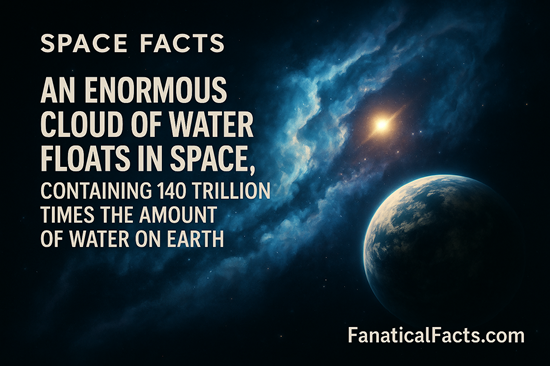
Body of water floating in space
One of the most incredible space facts reveals a massive body of water floating in space. This enormous cloud contains an astonishing 140 trillion times the amount of water found on Earth. Located billions of light-years away, it surrounds a distant quasar, making it the largest and most distant water reservoir ever discovered in the universe. These fascinating space facts highlight how much there is still to learn about the cosmos, showing that water—and life’s building blocks—exist far beyond our home planet.
Space Station (ISS)
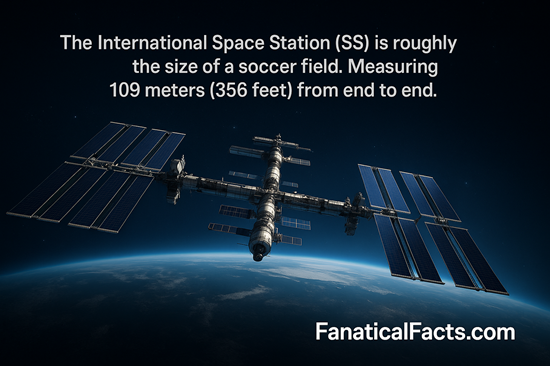
International Space Station (ISS)
One of the most fascinating space facts is that the International Space Station (ISS) is roughly the size of a soccer field. Measuring 109 meters (356 feet) from end to end, the ISS is nearly as long as an American football field, including its end zones. Its solar arrays span 73 meters (239 feet) wide, making the ISS not only massive in length but also in width. This incredible structure holds the title of the largest human-made object ever flown in space, highlighting the impressive scale of human achievement in orbit.
Space has no Sound
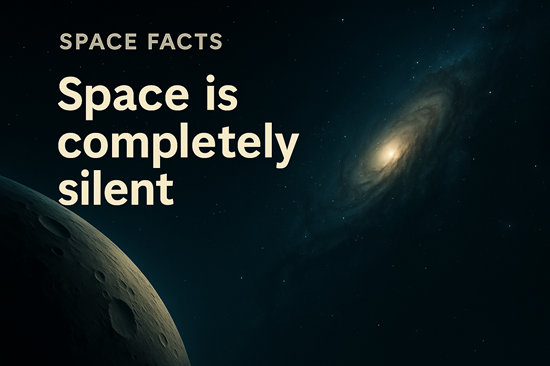
Space is completely silent
Did you know that space is completely silent? Unlike on Earth, where sound travels through air or water, space is a near-perfect vacuum with no atmosphere to carry sound waves. So, even though massive events like exploding stars or crashing asteroids happen out there, they happen in total silence. This eerie quietness makes space both fascinating and mysterious!
Venus is Hot

The hottest planet
One fascinating space fact is that Venus holds the title as the hottest planet in our solar system. Despite being farther from the Sun than Mercury, Venus’s thick atmosphere traps heat through a runaway greenhouse effect, causing surface temperatures to soar up to 900°F (475°C). This extreme heat can melt lead and makes Venus a fiery world unlike any other. These space facts remind us how planetary atmospheres dramatically influence climate, offering important lessons about Earth’s own environment and the power of nature’s forces.
Diamond in Space
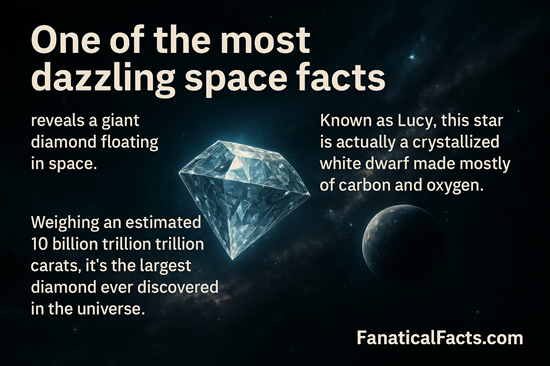
Giant diamond floating in space
One of the most dazzling space facts reveals a giant diamond floating in space. Known as Lucy, this star is actually a crystallized white dwarf made mostly of carbon and oxygen. Weighing an estimated 10 billion trillion trillion carats, it’s the largest diamond ever discovered in the universe. This amazing space fact highlights the incredible and surprising nature of the cosmos, reminding us that space holds endless wonders and treasures waiting to be explored and understood.
More to Explore


Explore the fascinating world of facts through our featured categories below. Each image link takes you directly to a curated section of FanaticalFacts.com. Designed with both visual engagement and intuitive navigation in mind.



